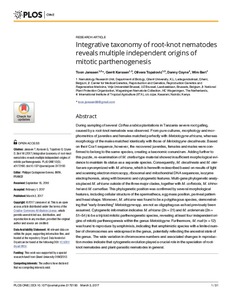| dc.contributor.author | Janssen, T. |
| dc.contributor.author | Karssen, G. |
| dc.contributor.author | Topalovic, O. |
| dc.contributor.author | Coyne, D.L. |
| dc.contributor.author | Bert, W. |
| dc.date.accessioned | 2019-12-04T11:07:51Z |
| dc.date.available | 2019-12-04T11:07:51Z |
| dc.date.issued | 2017-03-03 |
| dc.identifier.citation | Janssen, T., Karssen, G., Topalović, O., Coyne, D. & Bert, W. (2017). Integrative taxonomy of root-knot nematodes reveals multiple independent origins of mitotic parthenogenesis. PloS ONE, 12(3), e0172190, 1-31. |
| dc.identifier.issn | 1932-6203 |
| dc.identifier.uri | https://hdl.handle.net/20.500.12478/1619 |
| dc.description | Open Access Journal |
| dc.description.abstract | During sampling of several Coffea arabica plantations in Tanzania severe root galling, caused by a root-knot nematode was observed. From pure cultures, morphology and morphometrics of juveniles and females matched perfectly with Meloidogyne africana, whereas morphology of the males matched identically with those of Meloidogyne decalineata. Based on their Cox1 sequence, however, the recovered juveniles, females and males were confirmed to belong to the same species, creating a taxonomic conundrum. Adding further to this puzzle, re-examination of M. oteifae type material showed insufficient morphological evidence to maintain its status as a separate species. Consequently, M. decalineata and M. oteifae are synonymized with M. africana, which is herewith redescribed based on results of light and scanning electron microscopy, ribosomal and mitochondrial DNA sequences, isozyme electrophoresis, along with bionomic and cytogenetic features. Multi-gene phylogenetic analysis placed M. africana outside of the three major clades, together with M. coffeicola, M. ichinohei and M. camelliae. This phylogenetic position was confirmed by several morphological features, including cellular structure of the spermatheca, egg mass position, perineal pattern and head shape. Moreover, M. africana was found to be a polyphagous species, demonstrating that "early-branching" Meloidogyne spp. are not as oligophagous as had previously been assumed. Cytogenetic information indicates M. africana (2n = 21) and M. ardenensis (2n = 51-54) to be a triploid mitotic parthenogenetic species, revealing at least four independent origins of mitotic parthenogenesis within the genus Meloidogyne. Furthermore, M. mali (n = 12) was found to reproduce by amphimixis, indicating that amphimictic species with a limited number of chromosomes are widespread in the genus, potentially reflecting the ancestral state of the genus. The wide variation in chromosome numbers and associated changes in reproduction modes indicate that cytogenetic evolution played a crucial role in the speciation of root-knot nematodes and plant-parasitic nematodes in general. |
| dc.format.extent | 1-31 |
| dc.language.iso | en |
| dc.subject | Coffea |
| dc.subject | Meloidogyne |
| dc.subject | Root-Knot Nematodes |
| dc.subject | Mitotic Parthenogenesis |
| dc.subject | Integrative Taxonomy |
| dc.title | Integrative taxonomy of root-knot nematodes reveals multiple independent origins of mitotic parthenogenesis |
| dc.type | Journal Article |
| dc.description.version | Peer Review |
| cg.contributor.crp | Climate Change, Agriculture and Food Security |
| cg.contributor.affiliation | Ghent University |
| cg.contributor.affiliation | International Institute of Tropical Agriculture |
| cg.coverage.region | Africa |
| cg.coverage.region | East Africa |
| cg.coverage.country | Tanzania |
| cg.isijournal | ISI Journal |
| cg.authorship.types | CGIAR and advanced research institute |
| cg.iitasubject | Plant Diseases |
| cg.journal | PloS ONE |
| cg.howpublished | Formally Published |
| cg.accessibilitystatus | Open Access |
| local.dspaceid | 82461 |
| cg.targetaudience | Scientists |
| cg.identifier.doi | https://dx.doi.org/10.1371/journal.pone.0172190 |

